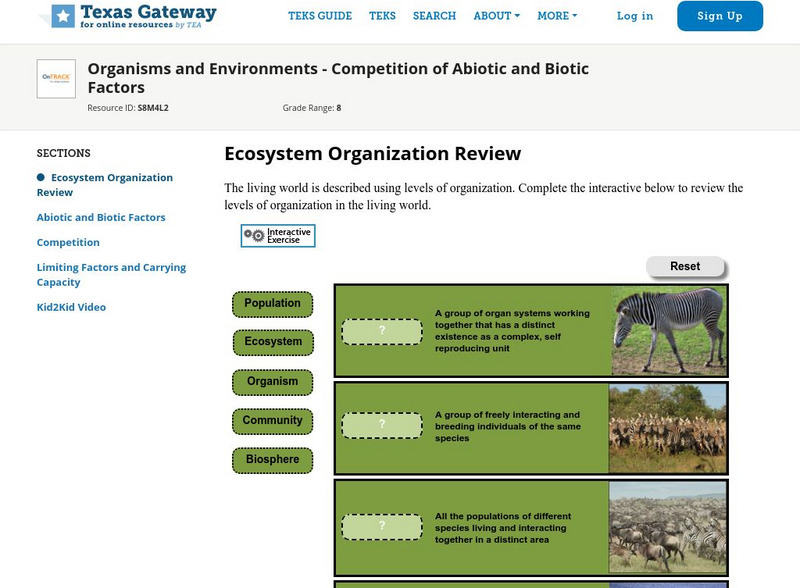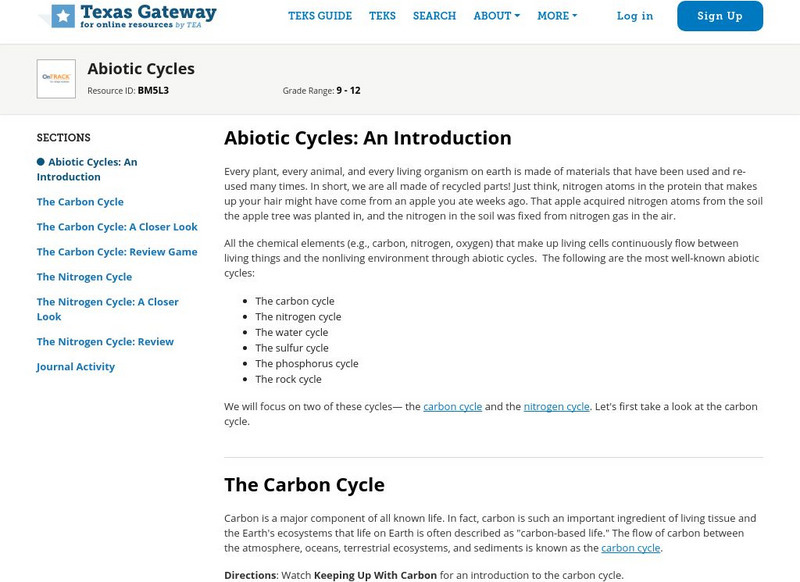Texas Education Agency
Texas Gateway: Competition of Abiotic and Biotic Factors
This tutorial explores abiotic and biotic factors with videos and interactive activities.
Oswego City School District
Regents Exam Prep Center: Biotic vs. Abiotic
This NY Regents prep site provides a nice overview of what abiotic and biotic factors of an ecosystem are, as well as a brief description of carrying capacity.
Other
University of the Western Cape: Department of Biodiversity: Abiotic Components
The Department of Biodiversity at UWC presents the impact different abiotic components on plants and animals. Some factors are light, temperature, and wind.
Texas Education Agency
Texas Gateway: Abiotic and Biotic Factors in an Ecosystem
Do you know the difference between abiotic and biotic factors? This tutorial explores both these factors and their importance in the ecosystem.
Sophia Learning
Sophia: Abiotic and Biotic Factors: Lesson 2
This lesson will introduce abiotic and biotic factors, giving examples and comparing/contrasting the two. It is 2 of 4 in the series titled "Abiotic and Biotic Factors."
Utah Education Network
Uen: Lesson Plan: Biotic and Abiotic Factors
This site provides a detailed lesson plan to help students grasp the concepts of biotic and abiotic. Background information is provided for the teacher and plans are given for two days.
Other
Abiotic Factors
Abiotic components are the nonliving components of the biosphere. Chemical and geological factors, such as rocks and minerals, and physical factors, such as temperature and weather, are referred to as abiotic components.
Encyclopedia of Earth
Encyclopedia of Earth: Ecology: Abiotic Factor
Explains what an abiotic factor is, and discusses each of six types and their roles in ecosystems and habitats. (Published: July 31, 2010)
Sophia Learning
Sophia: Abiotic and Biotic Factors: Lesson 4
This lesson will introduce abiotic and biotic factors, giving examples and comparing/contrasting the two. It is 4 of 4 in the series titled "Abiotic and Biotic Factors."
Sophia Learning
Sophia: Abiotic and Biotic Factors: Lesson 1
This lesson will introduce abiotic and biotic factors, giving examples and comparing/contrasting the two. It is 1 of 4 in the series titled "Abiotic and Biotic Factors."
National Geographic
National Geographic: Ocean Abiotic Factors
Students define and provide examples of abiotic and biotic factors of different ecosystems. Then they investigate the importance of abiotic factors and physical processes within ocean ecosystems.
That Quiz
That Quiz: Biotic or Abiotic? Living or Non Living?
This fun quiz has you choose between different images to decide whether it is biotic or abiotic. It also gives examples through illustrations of abiotic and biotic things.
McGraw Hill
Glencoe Online: Abiotic Factors
Take this 8 question check quiz on abiotic factors. The quiz is multiple choice.
CPALMS
Florida State University Cpalms: Florida Students: Diving the Depths of Underwater Life
A tutorial that explores how and why the distribution of aquatic life is affected by abiotic factors, such as light, temperature, and salinity.
Other
Hub Pages: Abiotic Factors: A Component of Ecosystem
In the environment, there are external factors that really affect organisms living within it. One of these factors is the set of abiotic factors, or nonliving variables, such as wind, ocean, day length, rainfall, temperature, and ocean...
Science Struck
Science Struck: Abiotic Factors of the Rainforest
Abiotic factors, e.g., sunlight and precipitation, play a huge role in supporting biodiversity in a rainforest. This article discusses the features of rainforests and how abiotic factors affect the plants and animals that live there.
McGraw Hill
Mc Graw Hill Ryerson: Abiotic and Biotic Environments
Take this ten question quiz on abiotic and biotic environments. The quiz is multiple choice.
Texas Education Agency
Texas Gateway: Abiotic Cycles
Given scenarios, illustrations, or descriptions, the student will describe the flow of matter through carbon and nitrogen cycles and describe the consequences of disrupting these cycles.
Huntington Library
Huntington Library: Making Community Measurements: Abiotic Factors [Pdf]
A lesson plan in which students explore plant communities and observe different types of soil and weather conditions in an attempt to determine cause and effect relationships. Includes discussion questions, extension activities and web...
Science Education Resource Center at Carleton College
Serc: Investigating the Long Meadow Lake Unit of Valley Nat'l Wildlife Refuge
This is a field investigation at the Bass Ponds Trailhead area in the MN Valley National Wildlife Refuge in which middle schoolers will collect data in the field and samples to test back in the classroom. Students will try to elicit the...
Other
Digital Library for Earth System Education: Teaching Box: Seasonal Upwelling
A suite of lessons focusing on the process of upwelling. Inquiry-based exploration of seasonal upwelling includes marine food webs, food production in the ocean, wind-driven ocean currents, and seasonal changes in biotic and abiotic...
National Geographic
National Geographic: Symbiotic Relationships in Marine Ecosystems
In this lesson students analyze videos to make observations about species, populations, and communities of organisms and discuss their symbiotic relationships. Then they create a hypothetical marine ecosystem and describe the adaptive,...
Concord Consortium
Concord Consortium: The Effect of Environmental Factors on the Growth of Plants
How do environmental factors affect the growth, development, and health of organisms? Students explore the effect of environmental factors on traits by investigating factors that affect the growth of plants.
Climate Literacy
Clean: Temperature and Precipitation as Limiting Factors in Ecosystems
Students correlate graphs of vegetation vigor with those of temperature and precipitation data for four diverse ecosystems, ranging from those near the equator to the poles, to determine which climatic factor is limiting growth.
Other popular searches
- Biotic Abiotic
- Biotic and Abiotic Factors
- Biotic and Abiotic
- Abiotic Biotic Environment
- Abiotic Elements
- Abiotic and Biotic Elements
- Abiotic and Biotic Resources
- Biotic Abiotic Factors
- Abiotic Biotic Lab
- Ecosystems Abiotic Biotic
- Biotic Abiotic Pictures
- Abiotic Factors River





















